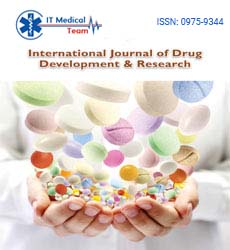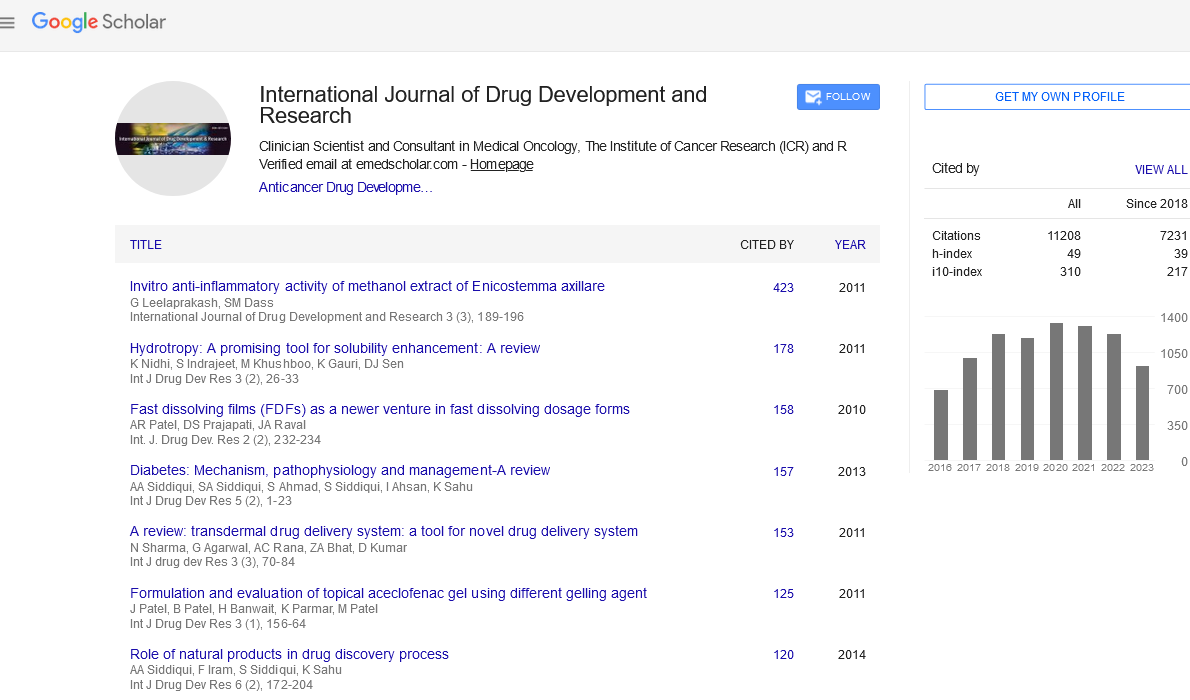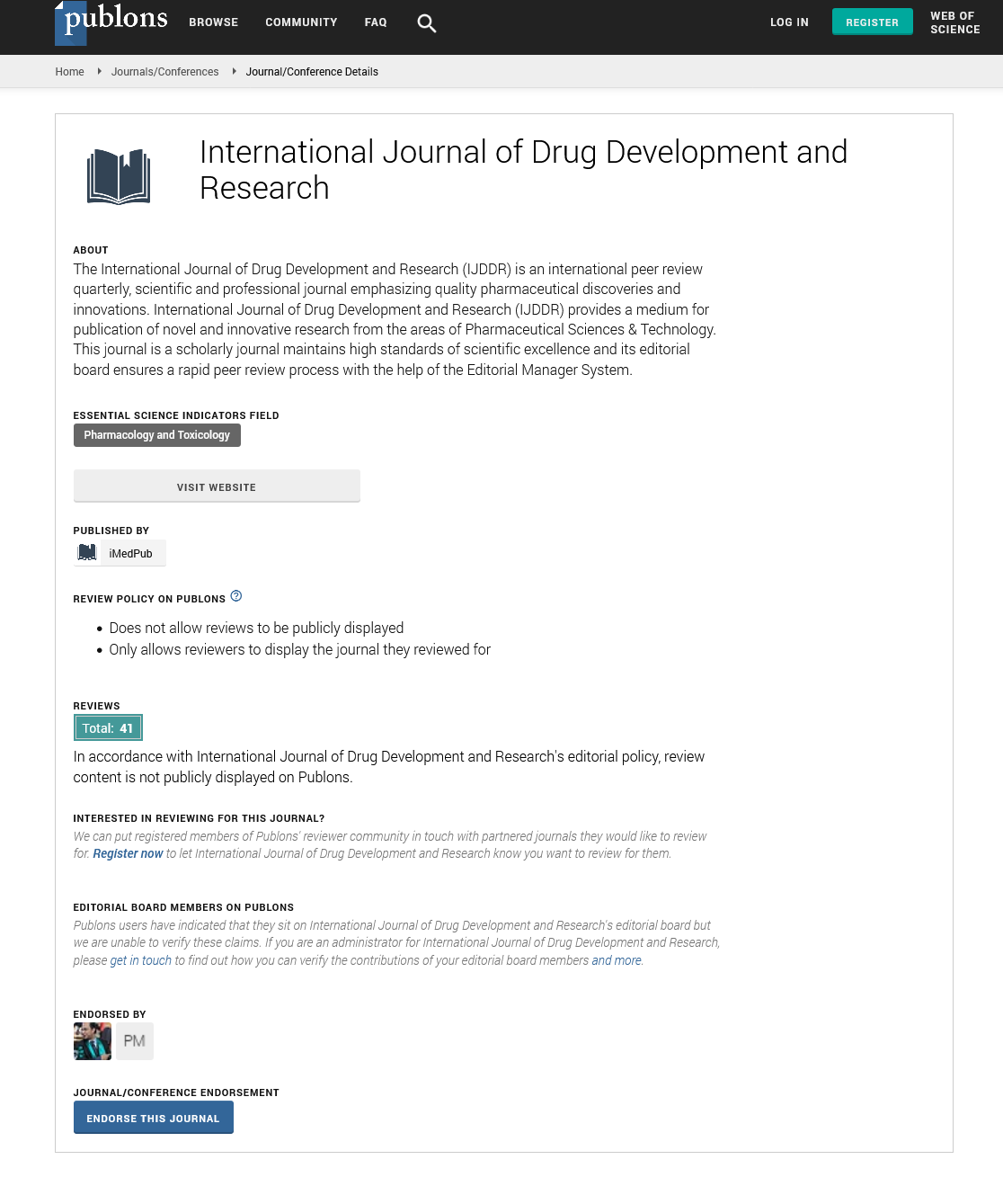Key words
|
| |
| Millingtonea hortensis, Methanolic extract, anti-inflammatory, analgesic. |
| |
INTRODUCTION
|
| |
| The defense mechanism of living tissues is many times pathologically manifested as inflammation. Drugs which are presently used for management of the pain and inflammatory conditions are either narcotics (e.g.: Opioids) or non-narcotics (e.g.: Salicylates and corticosteroids). All these drugs are having documented toxic effects. Use of steroidal and Non-Steroidal Anti- Inflammatory Drugs (NSAIDs) may lead to the Peptic ulcer formation [1]. So searching for the new anti-inflammatory drugs that posses therapeutic efficacy and yet are devoid of these adverse effects can be justified. |
| |
| Now-a-days, plant drugs are proved as effective as synthetic drugs with fewer side effects. For the last few decades, we are screening indigenous medicinal drug plants to develop safe and potent anti-inflammatory drugs for clinical use [2] [3]. Though some medicinal plants are reputed in indigenous system and medicine for their activities, such as Diopyros malabarica [4] and Morus indica.Linn [5], their efficacy remains to be scientifically proved. The present study is therefore, an attempt to assess the efficacy of Millingtonea hortensis. Linn, for its anti inflammatory and analgesic activities on animal models. |
| |
| INDIAN CORK TREE, Millingtonea hortensis. Linn is a tall tree, up to 25m height with straight trunk and elongated pyramidal shape crown with deep green foliage, cultivating throughout India as an ornament [6] tree. The matured stem bark is externally yellowish grey and internally cream color. Bark is 1-2 cm in thickness and slightly sweet in taste. It has no odour. Attractive fragrant flowers appear from September to December. Millingtonea hortensis. Linn is also grown as avenue tree [7]. The leaves and bark of the tree are used as anti pyretic in Indonesia[8]. |
| |
MATERIALS AND METHODS
|
| |
|
Materials:
|
| |
| Carrageenan was obtained from Sigma Chemical Co (MO, USA). Indomethacin (IMMECIN 50) was purchased from E.M. Pharmaceuticals Pvt. Ltd, Mumbai, India and Diclofenac sodium was from apex labs Chennai, India. All other chemicals and solvents were used analytical grade. |
| |
|
Collection of Plant
|
| |
| Millingtonea hortensis Linn. stem bark was collected from Kompally, RangaReddy district of Andhra Pradesh, India in the month of June 2009 and taxonomically identified and authenticated by Dr. Najma Unnisa, Botanist, Asst, professor, Sultan- Ul-Uloom College of Pharmacy, Hyderabad. The bark was cut into small pieces and dried under controlled temperature, and then it was powdered in mechanical grinder and then passed through #40 mesh sieve. |
| |
|
Preparation of Extract
|
| |
| The powdered material was extracted with Methanol (90%) and solvent was completely removed by vacuum distillation to give a brown residue (yield 8.3% w/w with respect to dried material). Standard phytochemical screening tests were carried out for the methanolic extract of Millingtonea hortensis (MEMH) bark. According to the methods of Trease and Evans, the presence of various phytoconstituents like sugars, terpenoids, tannins, flavinoids, glycosides, quinines, lignin, alkaloids and phenolic compounds were observed by preliminary phytochemical screening [9]. |
| |
|
Animals
|
| |
| Albino mice and Wister rats of either sex of approximately the same age, weighing between 20- 25 g and 150-175 g respectively, were used for study. They were placed in poly-propylene cage and fed with standard diet and water ad libitum.. The animals were exposed to 12 hours of light and darkness each. The conducted animal experiment was approved by Animal Ethical Committee of Sultan-Ul-Uloom College of pharmacy, Hyderabad. |
| |
ANTI-INFLAMMATORY ACTIVITY
|
| |
|
Carrageenan induced paw edema:
|
| |
| Paw edema was experimentally induced in rats by Carrageenan. To study the Carrageenan induced paw edema, the animal were divided into four groups of six in each (n=6). The MEMH was suspended in distilled water and administered orally at the dose level of 200 and 400 mg/kg body weight to the test groups II and III and Indomethacin at the dose level of 10 mg/kg body weight was administered orally to the standard group (Group IV). At the same time the control group received freshly prepared 0.3ml of normal saline (0.9% w/v NaCl) orally. After 30 minutes treatment with extract and standard drug, paw edema was induced by the injection of 0.1ml of 1% freshly prepared suspension of Carrageenan in normal saline solution into sub-plantar region of the left hind paw of each groups of rat[10]. The paw volume was measured immediately and then at 1hour, 2hours, 3hours, 4 hours and 5 hours intervals, after Carrageenan injection by Plethysmometer. |
| |
| Percentage reduction in edema volume was calculated by using the formula, |
| |
| Percentage reduction =(V0-Vt)/V0*100 |
| |
| Where, Vo = Volume of the paw of control at time‘t’, Vt = Volume of the paw of drug treated at time‘t’. |
| |
|
Different groups of animals were taken for experiment is as follows
|
| |
 |
| |
|
ANALGESIC ACTIVITY
|
| |
| The analgesic activity was studied by Tail-flick method by tail-withdrawal from the radient heat by using an instrument Analgesiometer[11] [12]. |
| |
|
Tail-Flick Method
|
| |
| In tail flick method, Albino mice of 20-25 g were randomly separated into four groups containing six animals in each group. The first group is taken as control and the animals were administered Normal saline. The second group animals served as standard animals and administered with Diclofenac sodium at dose of 1.0 mg/kg. The animals of third and fourth group were treated with 100 mg/kg and 200 mg/kg doses of MEMH respectively. After thirty minutes the mice were stimulated by concentrated light radiation from tail flick apparatus at the one third of their terminal tails. Response latency was recorded between time of exposure to light and tail withdrawal. The reaction time was noted at 15, 30, 45 minutes time intervals after drug administration. The animals which showed flicking response within 3-5 seconds were selected for the study. A cut off period of 15 seconds is observed to avoid damage to the tail. The response of the treated groups was compared with the animals in the control group. |
| |
|
Different groups of animals were taken for experiment is as follows:
|
| |
 |
| |
|
STATISTICAL ANALYSIS
|
| |
| The data obtained from the experiment were statistically analysed using one way ANOVA followed by Dannet’s test for individual comparision of groups with control. ‘p’Values <0.05 were considered as significant. All values of statistical data are expressed in Mean±SEM. |
| |
RESULTS
|
| |
| The percentage yield of Methanolic extraction was 8.3% w/v. Phytochemical screening reveals that methanolic extract of Millingtonea hortensis showed the presence of more number of active ingredients like Triterpinoids, Tannins, Flavonoids, Glycosides, Quinones, Lignins, Sugars etc. The methanolic extract of Millingtonea hortensis stem bark significantly reduced the paw edema induced by carrageenan at both (200 and 400 mg/ kg) dose levels compared to control group. Similarly the MEMH at 100 and 200 mg/kg showed significant delay in the tail flick response compared to control group when exposed to light radiation. These results indicating that the methanolic extract of Millingtonea hortensis stem bark posses antiinflammatory and analgesic activities. The results of anti-inflammatory activity were shown in Table – I and the Analgesic activity in Table – II. |
| |
DISCUSSION AND CONCLUSION
|
| |
| Carrageenan induced acute inflammation in animals is one of the most suitable test procedure to screen anti-inflammatory agents. The irritant effect of carrageenan is a result of activation of the kinin and complement cascades and consequently of the release of anti-inflammatory mediators such as vasoactive amines (Histamine, 5- Hydroxytryptamine) and eicosanoids. Inflammation has different phases; the first phase is caused by an increase in vascular permeability, the second one by infiltration of leukocytes and the third one by granuloma formation [13]. In our present investigation, MEMH showed significant reduction in paw edema volume in carragenan induced paw edema model in dose dependent manner and the anti-inflammatory effect of high dose (400 mg/kg) of methanolic extract of Millingtonea hortensis was comparable with standard indomethacin (15 mg/kg). |
| |
| We used tail flick method for determination of analgesic activity. In this study MEMH was able to increase in the reaction time (increase threshold potential of pain) compared to control group. Present results conclude that the methanolic extract stem bark of Millingtonea hortensis possess significant anti-inflammatory and analgesic activity. |
| |
ACKNOWLEDGEMENT
|
| |
| The authors are thankful Dr. D. Satyavati, Principal and Marri Laxman Reddy, Chairman, MLR Institute of Pharmacy, Hyderabad and Principal and management members of Sultan-Ul-Uloom College of Pharmacy, Hyderabad, India for providing all necessary facilities to carry out the research work and their constant support. |
| |
Conflict of Interest
|
| |
| NONE |
| |
Source of Support
|
| |
| NIL |
| |
Tables at a glance
|
 |
 |
| Table 1 |
Table 2 |
|
| |








